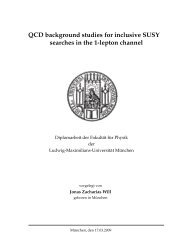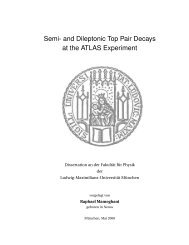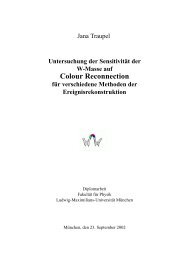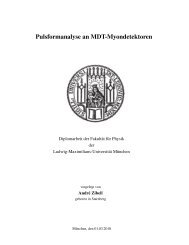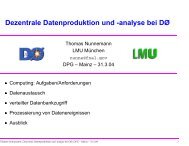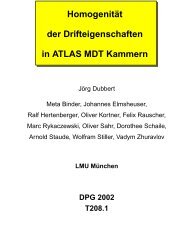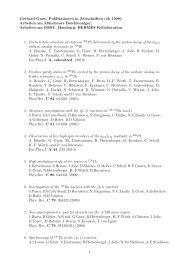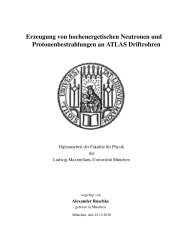development of micro-pattern gaseous detectors – gem - LMU
development of micro-pattern gaseous detectors – gem - LMU
development of micro-pattern gaseous detectors – gem - LMU
You also want an ePaper? Increase the reach of your titles
YUMPU automatically turns print PDFs into web optimized ePapers that Google loves.
22 Chapter 2 The GEM Principle<br />
double-conical shape (see Fig. 2.1). This shape is a compromise due to research results, as a nonrealizable<br />
cylindrical shape should be preferred [Benl 98] to keep the walls from charging-up. Due<br />
to irregularities in the material, local defects or even total removal <strong>of</strong> the kapton layer may occur<br />
after an etching process for cylindrical holes [Altu 02]. The double-conical geometry was introduced<br />
to improve the dielectric rigidity and also to prevent shortcuts between the upper and lower copper<br />
cladded side <strong>of</strong> the foil under operation at e.g. ∆U<strong>gem</strong> ≈ 350 V.<br />
A typical GEM foil, or shortly GEM, as it is designed by the CERN workshop, consists <strong>of</strong> a 50 µm<br />
kapton layer covered on both sides by 5 µm thick copper films. Since the holes are double-conically<br />
shaped, one can define two diameters, see Fig. 2.1. The inner diameter in kapton is about 50 µm and<br />
the outer one in copper about 70 µm, with a center-to-center distance <strong>of</strong> 140 µm [Saul 97] and [Bij<br />
05].<br />
The ratio <strong>of</strong> material liberated area to total area <strong>of</strong> the foil is defined by the optical transparency<br />
[Simo 01]<br />
τ =<br />
perforated area<br />
unit cell<br />
= π d<br />
2<br />
2<br />
√ 3<br />
2 · P2 = 2 √ 3 · π<br />
2 d<br />
P<br />
where d is the inner diameter and P the pitch <strong>of</strong> the holes as denoted in Fig. 2.1. The GEMs used<br />
here provide a τ ≈ 0.46. Fig. 2.2 presents a <strong>micro</strong>scopic view <strong>of</strong> such a foil.<br />
Figure 2.2: Microscopic pictures <strong>of</strong> the GEM foil. On the left the cross-section <strong>of</strong> a hole [Altu 02]. Size <strong>of</strong><br />
holes and pitch are 70 µm and 140 µm, respectively [Saul 03].<br />
2.2 The GEM Foil Principle<br />
Applying high voltage to the GEM’s copper electrodes generates an electric field inside the holes<br />
as high as 55 kV /cm, for a given voltage difference <strong>of</strong> ∆UGEM = 350V . Placed in an appropriate<br />
gas-filled environment, this field is able to provide energies for the electrons that are high enough for<br />
gas amplification. The simplest way to build a particle detector including a GEM foil is by inserting<br />
the foil in a parallel plate electric field, generated by a drift electrode and a charge collection anode<br />
(cf. Fig. 2.3).<br />
Electron-ion pairs, created by a traversing ionizing particle, are separated in the electric field <strong>of</strong> the<br />
upper drift gap. As shown in Fig. 2.3, the electrons drift towards the holes, where they undergo gas<br />
amplification, due to the high field in the GEM. The multiplied charge is guided by the field lines<br />
into the so-called induction region to the anode structure, from where it can be readout.<br />
(2.1)



